Dynamic Load Flow in Modern Power Systems: Renewables, Crypto Mining, and Electric Vehicles
Abstract
1. Introduction
2. Materials and Methods
2.1. Numerical Analysis Method
- i.
- The oscillation bus, also referred to as the reference bus, was where the voltage magnitude (|V|) and phase angle = v(δ) were known and the active (P) and reactive FDV power (Q) were determined. This bus was used to assess the difference between the generated power and the planned load caused by losses in the power system.
- ii.
- Load buses, also known as P−Q buses, were where the active (P) and reactive power (Q) were known and the voltage magnitude (|V|) and phase angle (δ) of the bus were determined. As power was consumed in these buses, the values of the active and reactive power became negative.
- iii.
- Generation buses, also known as P−V buses or voltage-controlled buses, were where the active power (P) and voltage magnitude (|V|) were known and the voltage phase angle (δ) and reactive power (Q) were determined.
Newton−Raphson Method
- It offers faster convergence in dynamic systems.
- It handles nonlinearities in RES and Bitcoin-mining loads more effectively.
- It provides higher accuracy compared to Gauss−Seidel and FDLF under varying load conditions.
- Maximum voltage error: The deviation between calculated and actual voltages, which remained below 1% across all scenarios.
- Power factor-estimation accuracy: The estimated power factor varied within ±0.02 of the actual values under different load conditions.
- Comparison of computational time: The Newton−Raphson method achieved convergence within 4–6 iterations, while Gauss−Seidel required 20+ iterations for similar accuracy.
2.2. 24-h Dynamic Load-Flow Analysis Based on the Newton−Raphson Method
3. Results and Discussion
3.1. Analyses of 24-h Dynamic Load Flow on the IEEE 14-Bus Test System
3.2. Model Validation and Limitations of Study
- Statistical evaluation of voltage stability and power factor variations,
- Identification of buses exceeding nominal voltage and power factor limits,
- Assessment of the impact of intermittent distributed generation and variable load demand on grid stability.
- Weather conditions: The impact of seasonal variations on renewable energy production was not fully considered, meaning solar and wind fluctuations were modeled based on general trends rather than location-specific data.
- Control strategies: The study does not include advanced inverter-control mechanisms or demand-side management strategies, which could further optimize grid stability.
- Real-world validation: The results are based on simulations rather than real-world grid measurements. Future research should incorporate experimental testing with real-time grid data to validate the simulation outcomes.
3.3. Simulation-Based Analysis and Discussion of Results
4. Conclusions
- Voltage stability: The integration of renewable distributed energy sources does not significantly impact voltage stability, as the total energy balance in the system is maintained. However, buses with a high share of local renewable generation exhibit slight voltage fluctuations due to variations in active and reactive power balance.
- Maximum daily voltage fluctuation: 0.8% at Bus 13.
- Voltage levels remained stable (zero variability) at generation buses (Buses 1–3).
- Power factor variability: The integration of renewable energy influences power factor stability, particularly in buses where local generation meets a substantial portion of demand.
- Lowest power factor observed: 0.599 at Bus 3, due to the imbalance between active and reactive power.
- Power factor remained stable in transition buses (Buses 4, 5, 9, and 12), as they were not subject to a direct load and did not directly generate power.
- Impact of load demand: As power demand on the grid increases, voltage variations become more pronounced, particularly at load and transition buses.
- Peak Bitcoin-mining consumption at 02:00 caused localized voltage dips.
- High generation of solar energy at 13:00 led to voltage increases, with potential overvoltage risks.
- Role of Bitcoin-mining loads: Unlike other high-demand applications, Bitcoin-mining operations contribute to grid stability due to their relatively steady consumption patterns.
- Bitcoin-mining loads exhibited minimal intra-day power factor fluctuations compared to other loads.
- Their stable consumption can help mitigate reactive power fluctuations, reducing overall grid instability.
- Need for dynamic grid management: Static power system models are insufficient to capture real-time imbalances. Instead, a dynamic approach is essential for effective grid operation.
- Adaptive inverter control, smart demand response, and energy-storage integration can help mitigate power quality disturbances.
- Real-time monitoring and forecasting techniques should be prioritized to enhance grid resilience and reliability.
- Implement real-time optimization strategies for integrating renewable energy into networks that support Bitcoin mining and EV charging.
- Develop more advanced forecasting and adaptive control mechanisms to maintain power factor stability.
- Investigate the impact of varying levels of penetration of renewable energy on long-term grid reliability and efficiency.
Funding
Institutional Review Board Statement
Informed Consent Statement
Data Availability Statement
Conflicts of Interest
References
- Treiblmaier, H. A comprehensive research framework for Bitcoin’s energy use: Fundamentals, economic rationale, and a pinch of thermodynamics. Blockchain Res. Appl. 2023, 4, 100149. [Google Scholar] [CrossRef]
- Lotfi, R.; Zare, S.G.; Gharehbaghi, A.; Nazari, S.; Weber, G.-W. Robust optimization for energy-aware cryptocurrency farm location with renewable energy. Comput. Ind. Eng. 2023, 177, 109009. [Google Scholar] [CrossRef]
- Yin, W.; Ji, J.; Qin, X. Study on optimal configuration of EV charging stations based on second-order cone. Energy 2023, 284, 128494. [Google Scholar] [CrossRef]
- Tabar, V.S.; Ghassemzadeh, S.; Tohidi, S. Risk-based day-ahead planning of a renewable multi-carrier system integrated with multi-level electric vehicle charging station, cryptocurrency mining farm and flexible loads. J. Clean. Prod. 2022, 380, 134898. [Google Scholar] [CrossRef]
- Peças Lopes, J.A.; Hatziargyriou, N.; Mutale, J.; Djapic, P.; Jenkins, N. Integrating distributed generation into electric power systems: A review of drivers, challenges and opportunities. Electr. Power Syst. Res. 2006, 7, 1189–1203. [Google Scholar] [CrossRef]
- Wang, K.; Zhang, Z.; Kim, H.S. ReviewChain: Smart Contract Based Review System with Multi-Blockchain Gateway. In Proceedings of the 2018 IEEE International Conference on Internet of Things (iThings) and IEEE Green Computing and Communications (GreenCom) and IEEE Cyber, Physical and Social Computing (CPSCom) and IEEE Smart Data (SmartData), Halifax, NS, Canada, 30 July–3 August 2018. [Google Scholar]
- Wang, X.; Yang, W.; Noor, S.; Chen, C.; Guo, M.; Dam, K.h.v. Blockchain-based smart contract for energy demand management. Energy Procedia 2019, 168, 2719–2724. [Google Scholar] [CrossRef]
- Shafiei, M.; Ghasemi-Marzbali, A. Fast-charging station for electric vehicles, challenges and issues: A comprehensive review. J. Energy Storage 2022, 49, 104136. [Google Scholar] [CrossRef]
- García-Villalobos, J.; Zamora, I.; San Martín, J.L.; Asensio, F.J.; Aperribay, V. Plug-in electric vehicles in electric distribution networks: A review of smart charging approaches. Renew. Sustain. Energy Rev. 2014, 38, 717–731. [Google Scholar] [CrossRef]
- Rodriguez-Calvo, A.; Cossent, R.; Frías, P. Integration of PV and EVs in unbalanced residential LV networks and implications for the smart grid and advanced metering infrastructure deployment. Int. J. Electr. Power Energy Syst. 2017, 91, 121–134. [Google Scholar] [CrossRef]
- Li, J.; Li, N.; Peng, J.; Cui, H.; Wu, Z. Energy consumption of cryptocurrency mining: A study of electricity consumption in mining cryptocurrencies. Enegry 2019, 168, 1189–1203. [Google Scholar] [CrossRef]
- Kaygusuz, A.; Gül, O.; Alagöz, B.B. An analysis for impacts of renewable distributed generation conditions on the load flow stability of electrical power system. EMO Bilimsel Dergi Elektr. Elektron. Bilgi. Biyomedikal Mühendisliği Bilimsel Dergi 2012, 2, 77–85. [Google Scholar]
- Tinney, W.F.; Hart, C.E. Power Flow Solution by Newton’s Method. IEEE Trans. Power App. Syst. 1967, 86, 1449–1460. [Google Scholar] [CrossRef]
- Zimmerman, R.D.; Chiang, H.D. Fast Decoupled Power Flow for Unbalanced Radial Distribution Systems. IEEE Trans. Power Syst. 1995, 10, 2045–2052. [Google Scholar] [CrossRef]
- Stott, B.; Alsaq, O. Fast Decoupled Load Flow. IEEE Trans. Power Appar. Syst. 1974, 3, 859–869. [Google Scholar] [CrossRef]
- Moorthy, S.; Al-Dabbagh, M.; Vawser, M. Improved Phase–Cordinate Gauss-Seidel Load Flow Algorithm. Electr. Power Syst. Res. 1995, 34, 91–95. [Google Scholar] [CrossRef]
- Zang, W.; Liu, Y. Reactive Power Optimization Based on PSO in a Partical Power System. In Proceedings of the Power Engineering Society General Meeting, 2004 IEEE, Denver, CO, USA, 6–10 June 2004; Volume 1, pp. 239–243. [Google Scholar]
- Vlachogiannis, J.Q. Fuzzy Logic Application in Load Flow Studies. IEE Proc. Gener. Transm. Distrib. 2001, 148, 34–40. [Google Scholar] [CrossRef]
- Storn, R.; Price, K. Differential Evolution-a Simple and Efficient Heuristic for Global Optimization over Continuous Spaces. J. Glob. Optim. 1997, 11, 341–359. [Google Scholar] [CrossRef]
- Li, Z.; Shi, J.; Liu, Y. Distributed Reactive Power Optimization and Programming for Area Power System. In Proceedings of the International Conference on Power System Technology, POWERCOM 2004, Singapore, 21–24 November 2004; Volume 2, pp. 1447–1450. [Google Scholar]
- Wei, H.; Cong, Z.; Jingyan, Y.; Jianhua, Z.; Zifa, L.; Zhilian, W.; Dongli, P. Using Bacterial Chemotaxis Method for Reactive Power Optimization. In Proceedings of the 2008 IEEE/PES Transmission and Distribution Conference and Exposition, Chicago, IL, USA, 21–24 April 2008; pp. 1–7. [Google Scholar]
- Shirmohammadi, D.; Hong, H.W.; Semlyen, A.; Luo, G.X. Compensation-Based Power Flow Method for Weakly Meshed Distribution and Transmission Networks. IEEE Trans. Power Syst. 1988, 3, 753–762. [Google Scholar] [CrossRef]
- Absar, M.N.; Islam, M.F.; Ahmed, A. Power quality improvement of a proposed grid-connected hybrid system by load flow analysis using static var compensator. Heliyon 2023, 9, e17915. [Google Scholar] [CrossRef]
- Dai, Y.; Zhang, L.; Chen, Q.; Zhou, K.; Hua, T. Multi-VSG-Based Frequency Regulation for Uninterruptible Power AC Micro-Grid with Distributed Electric Vehicles. Int. J. Electr. Power Energy Syst. 2022, 137, 107785. [Google Scholar] [CrossRef]
- Askarov, A.; Rudnik, V.; Ruban, N.; Radko, P.; Ilyushin, P.; Suvorov, A. Enhanced Virtual Synchronous Generator with Angular Frequency Deviation Feedforward and Energy Recovery Control for Energy Storage System. Mathematics 2024, 12, 2691. [Google Scholar] [CrossRef]
- Saadat, H. Power Systems Analysis; McGraw Hill: Boston, MA, USA, 1999. [Google Scholar]
- Huang, S.; Xiong, L.; Zhou, Y.; Gao, F.; Jia, Q.; Li, X.; Li, X.; Wang, Z.; Khan, M.W. Robust Distributed Fixed-Time Fault-Tolerant Control for Shipboard Microgrids With Actuator Fault. IEEE Trans. Transp. Electrif. 2025, 11, 1791–1804. [Google Scholar] [CrossRef]
- Hajiaghapour-Moghimi, M.; Heydari Tafreshi, O.; Hajipour, E.; Vakilian, M.; Lehtonen, M. Investigating the Cryptocurrency Mining Loads’ High Penetration Impact on Electric Power Grid. IEEE Access 2024, 12, 153643–153663. [Google Scholar] [CrossRef]
- Akhter, A.F.M.S.; Arnob, T.Z.; Noor, E.B.; Hizal, S.; Pathan, A.-S.K. An Edge-Supported Blockchain-Based Secure Authentication Method and a Cryptocurrency-Based Billing System for P2P Charging of Electric Vehicles. Entropy 2022, 24, 1644. [Google Scholar] [CrossRef]
- Malik, A.W.; Anwar, Z. Do Charging Stations Benefit from Cryptojacking? A Novel Framework for Its Financial Impact Analysis on Electric Vehicles. Energies 2022, 15, 5773. [Google Scholar] [CrossRef]
- Basu, S.; Mahapatra, G.S. Numerical solution of fuzzy non-linear equations under generalized trapezoidal fuzziness by Newton–Raphson method. Frankl. Open 2024, 9, 100168. [Google Scholar] [CrossRef]
- Bayat, M.; Koushki, M.M.; Ghadimi, A.A.; Véliz, M.T.; Jurado, F. Comprehensive enhanced Newton Raphson approach for power flow analysis in droop-controlled islanded AC microgrids. Int. J. Electr. Power Energy Syst. 2022, 143, 108493. [Google Scholar] [CrossRef]
- Pandya, K.; Joshi, S.K. A survey of optimal power flow methods. J. Theor. Appl. Inf. Technol. 2008, 4, 450–458. [Google Scholar]
- Zhong, X.; Xin Li, G.; Zhng, C. False data injection in power smart grid and identification of the most vulnerable bus; a case study 14 IEEE bus network. Energy Rep. 2021, 7, 8476–8484. [Google Scholar] [CrossRef]
- Yip, A.; Hoehne, C.; Jadun, P.; Ledna, C.; Hale, E.; Muratori, M. Highly Resolved Projections of Passenger Electric Vehicle Charging Loads for the Contiguous United States: Results From and Methods Behind Bottom-Up Simulations of County-Specific Household Electric Vehicle Charging Load (Hourly 8760) Profiles Projected Through 2050 for Differentiated Household and Vehicle Types; National Renewable Energy Laboratory: Golden, CO, USA, 2023. [Google Scholar]

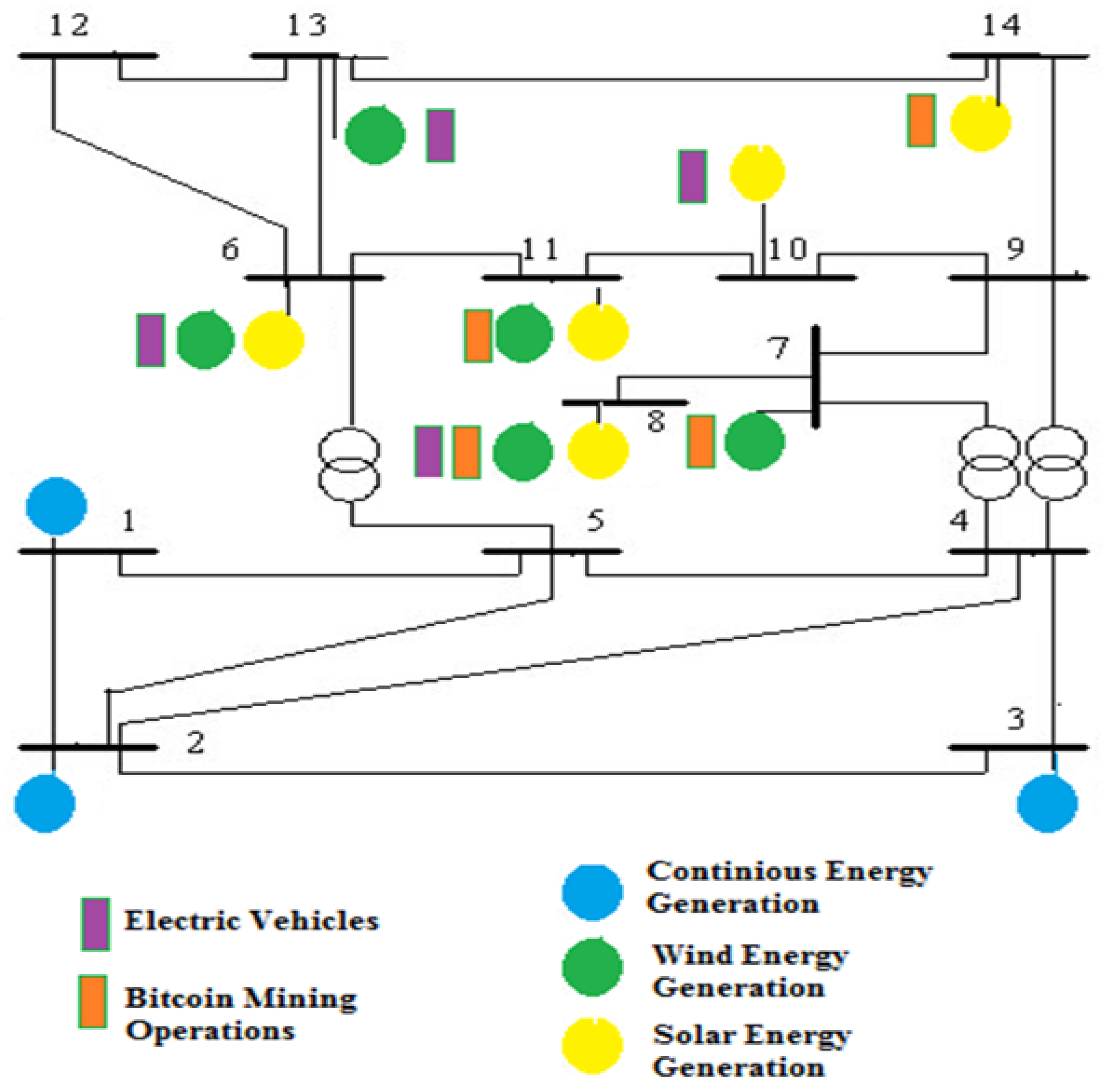
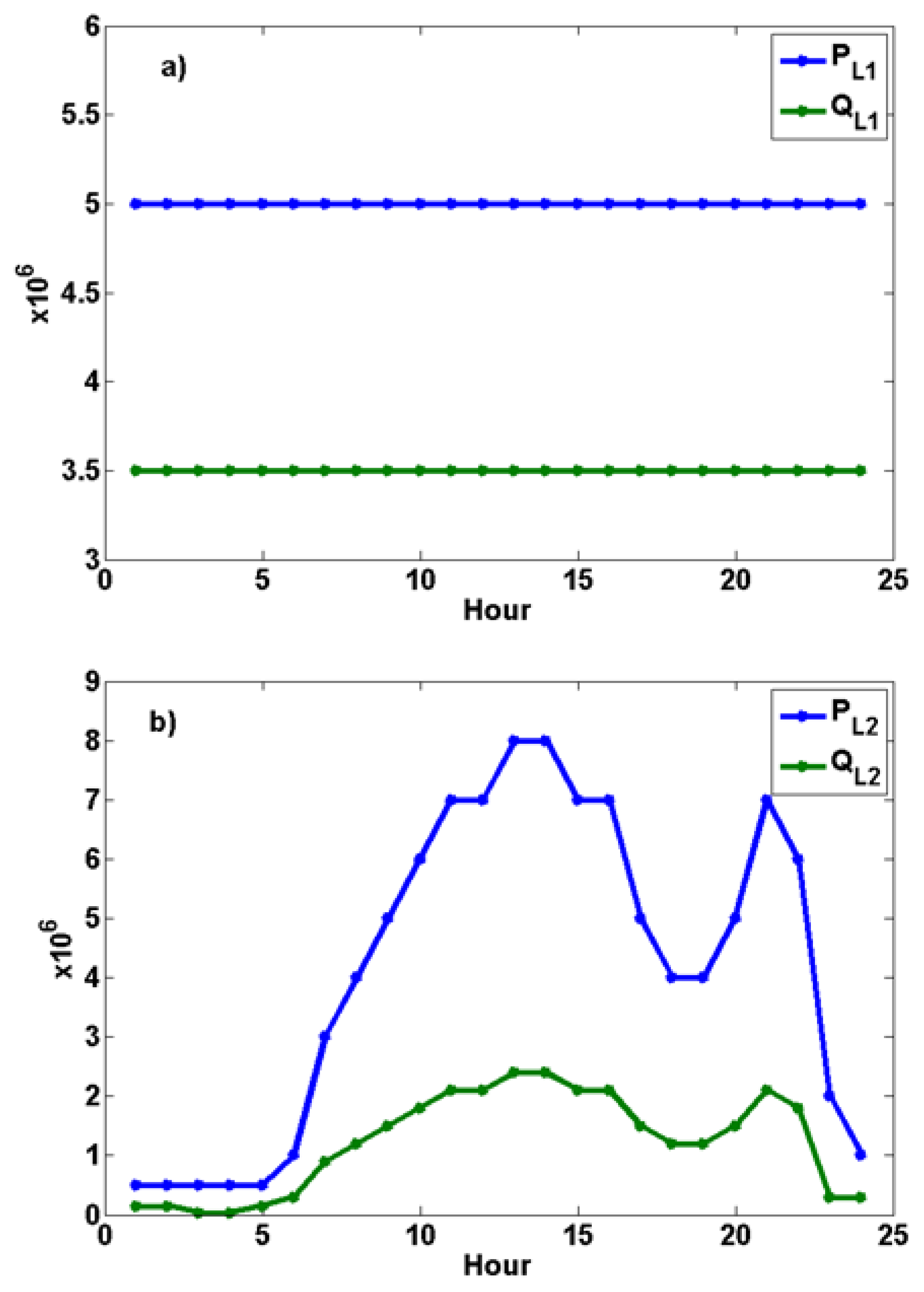
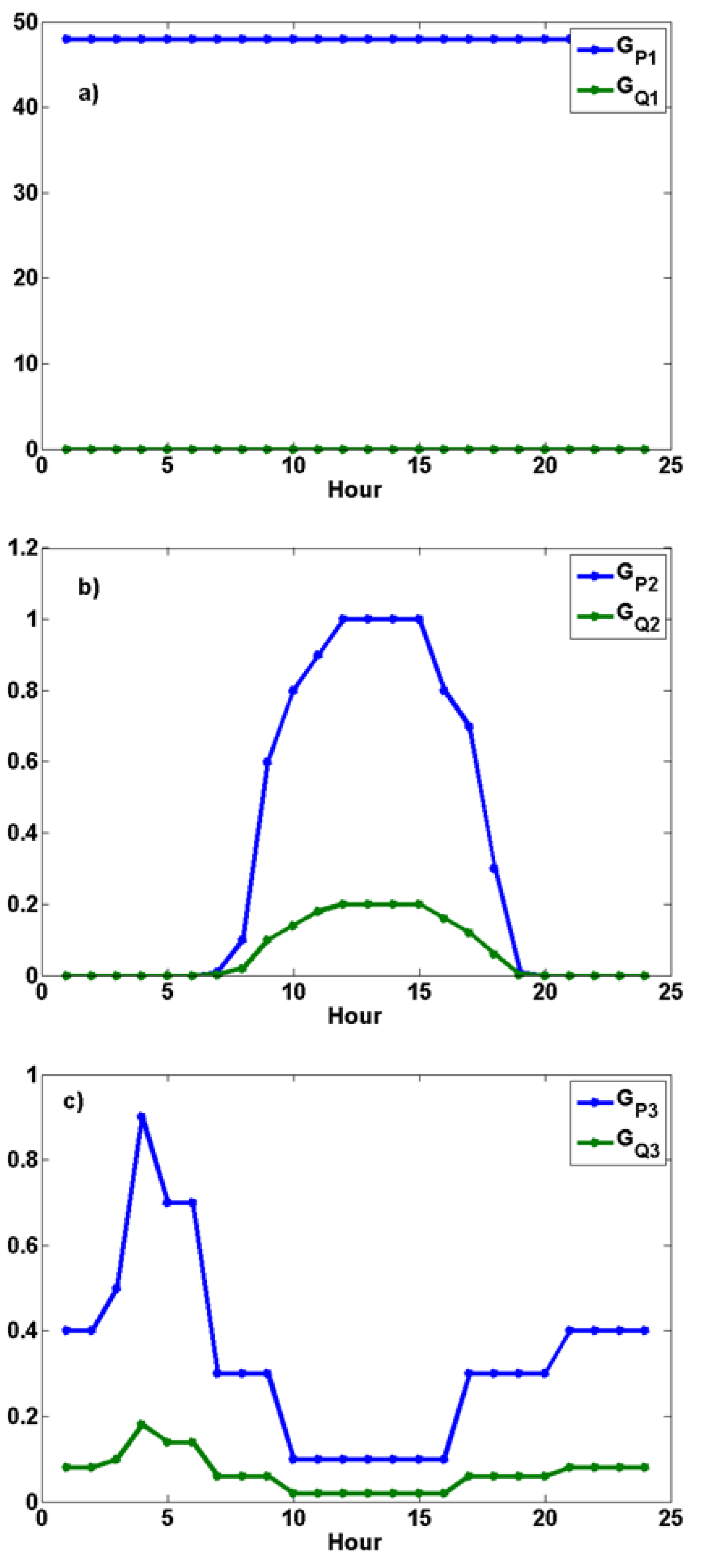

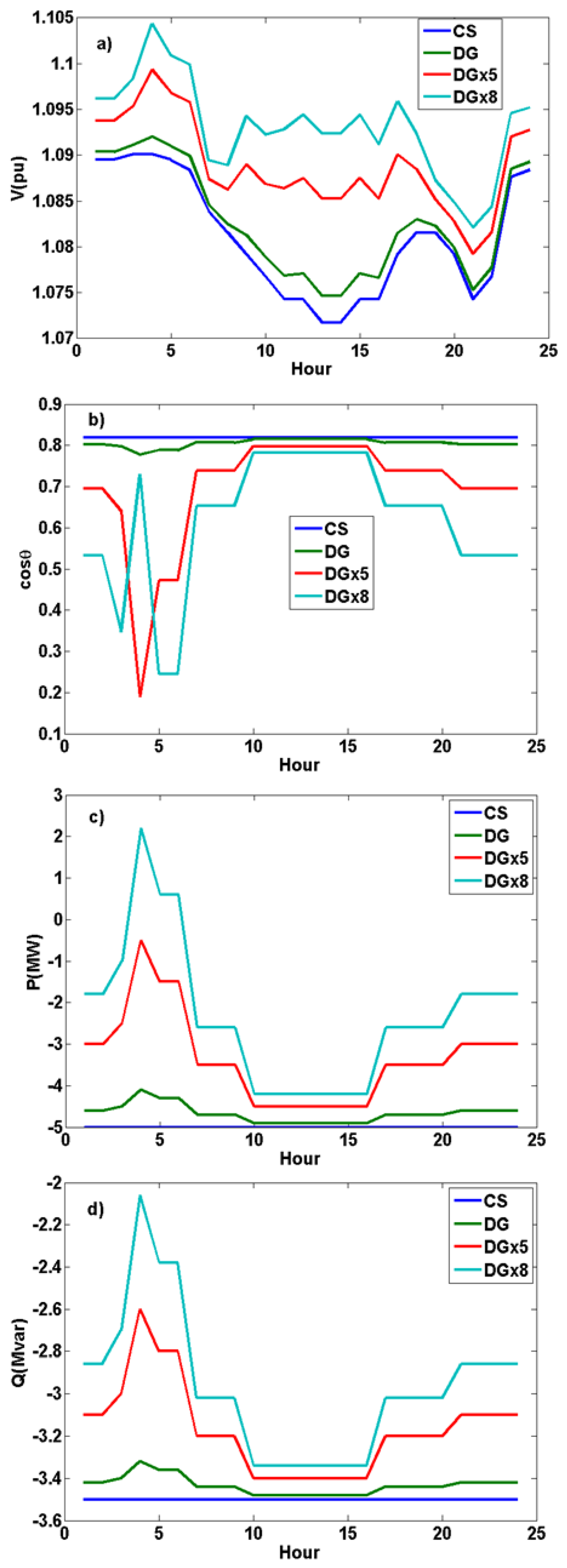

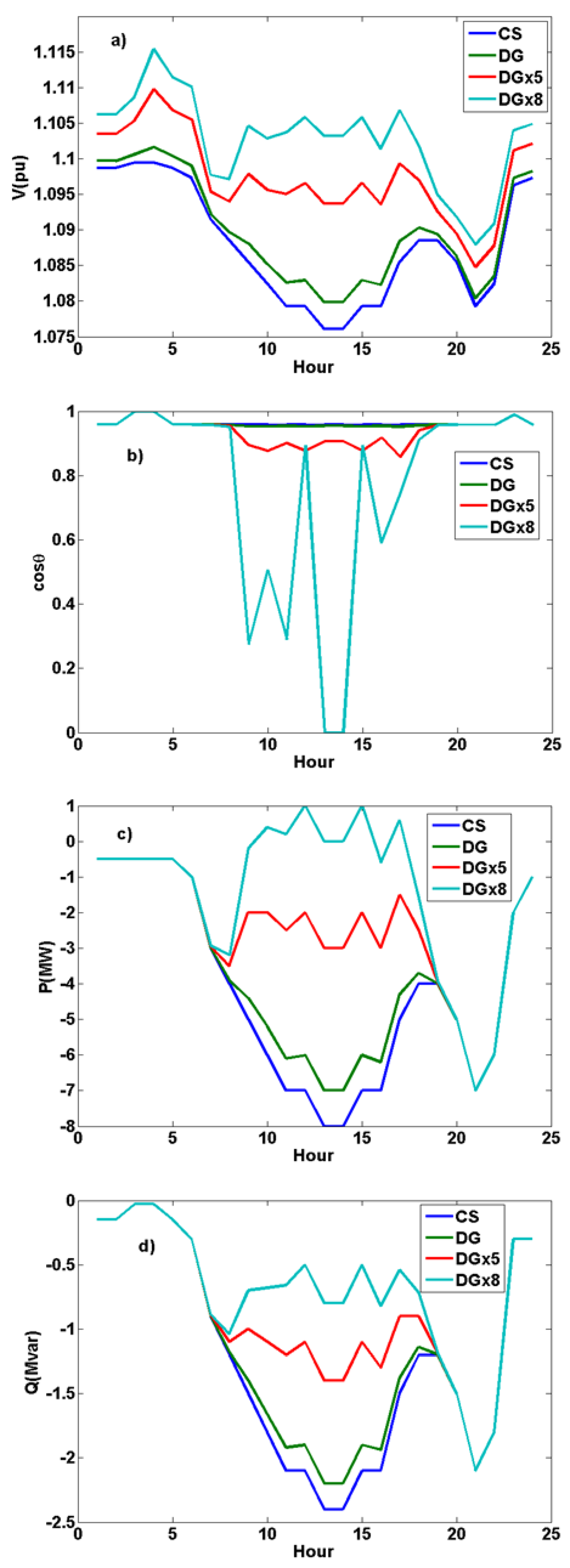
| Method | Advantages | Disadvantages |
|---|---|---|
| Newton−Raphson | Quadratic convergence; efficient for large systems; solution steps independent of system size. | High computational cost per iteration; requires Jacobian matrix computation. |
| Gauss−Seidel | Simple implementation; low memory and computational requirements. | Slow convergence; not suitable for large-scale systems. |
| Fast-Decoupled | Faster than Newton−Raphson; computationally efficient; well-suited for large power systems. | Lower accuracy in weakly meshed or low-voltage networks. |
| Parameter | Value | Description |
|---|---|---|
| Base Power (MVA) | 100 | Power system base power |
| Accuracy Threshold | 0.001 | Convergence accuracy for Newton−Raphson |
| Maximum Iterations | 10 | Maximum allowable iterations for convergence |
| Bus No | Vσ(CS–LDx3–LDx7) | cosθσ(CS–LDx3–LDx7) |
|---|---|---|
| 1 | 0%–0%–0% | 1.6%–13%–68% |
| 2 | 0%–0%–0% | 36%–16%–98% |
| 3 | 0%–0%–0% | 12%–50%–30% |
| 4 | 0.35%–2%–10.6% | –%–%– |
| 5 | 0.32%–2.5%–11.2% | %–%–%– |
| 6 | 0.7%–4.6%–8.3% | 1.3%–1.3%–1.3% |
| 7 | 0.6%–4.3%–51.7% | 0.01%–0.01%–0.01% |
| 8 | 0.7%–5.2%–22.05% | 3.2%–3.2%–3.2% |
| 9 | 0.6%–4.4%–32.57% | %–%–%– |
| 10 | 0.7%–5%–7.89% | 1.3%–1.3%–1.3% |
| 11 | 0.68%–5%–6.89% | 0.01%–0.01%–0.01% |
| 12 | 0.77%–4.9%–8.8% | %–%–%– |
| 13 | 0.87%–5.36%–31.3% | 1.3%–1.3%–1.3% |
| 14 | 0.75%–5.16%–31.4% | 0.01%–0.01%–0.01% |
| Bus No | Vδ(DG–DGx5–DGx8) | cosθδ(DG–DGx5–DGx8) |
|---|---|---|
| 1 | 0%–0%–0% | 1.5%–1.3%–1.3% |
| 2 | 0%–0%–0% | 3.3%–2.5%–2.5% |
| 3 | 0%–0%–0% | 9.8%–6.0%–5.8% |
| 4 | 0.31%–0.26%–0.27% | –%–%– |
| 5 | 0.30%–0.25%–0.26% | –%–%– |
| 6 | 0.66%–0.56%–0.56% | 21.85–32.5%–16.4% |
| 7 | 0.56%–0.46%–0.48% | 1.2%–20%–26.3% |
| 8 | 0.69%–0.58%–059% | 3.9%–15.4%–31.2% |
| 9 | 0.58%–0.48%–0.49% | –%–%– |
| 10 | 0.70%–0.56%–0.59% | 1.4%–4.3%–41.2% |
| 11 | 0.68%–0.57%–0.63% | 2%–59.5%–36.6% |
| 12 | 0.73%–0.62%–0.62% | –%–%– |
| 13 | 0.82%–0.72%–0.71% | 21.3%–21.3%–3.8% |
| 14 | 0.67%–0.54%–0.63% | 2.5%–55.5%–27.5% |
| Bus No | Voltage (p.u) | Power Factor | Active Power (MW) | Reactive Power (MVar) |
|---|---|---|---|---|
| 1 | 1.100 | 0.84682 | 48.000 | 30.148 |
| 2 | 1.095 | 0.79533 | 48.000 | 36.583 |
| 3 | 1.010 | 0.59944 | −46.646 | −62.284 |
| 4 | 1.059 | NaN | 0.000 | 0.000 |
| 5 | 1.067 | NaN | 0.000 | 0.000 |
| 6 | 1.106 | 0.95354 | 1.100 | 0.200 |
| 7 | 1.075 | 0.81530 | 0.100 | 0.020 |
| 8 | 1.065 | 0.90246 | 1.100 | 0.220 |
| 9 | 1.080 | NaN | 0.000 | 0.000 |
| 10 | 1.080 | 0.95399 | 1.000 | 0.200 |
| 11 | 1.088 | 0.76531 | 1.100 | 0.220 |
| 12 | 1.101 | NaN | 0.000 | 0.000 |
| 13 | 1.095 | 0.95749 | 0.100 | 0.020 |
| 14 | 1.079 | 0.771373 | 1.000 | 0.200 |
| Bus No | Voltage (p.u) | Power Factor | Active Power (MW) | Reactive Power (MVar) |
|---|---|---|---|---|
| 1 | 1.110 | 0.88184 | 48.000 | 25.667 |
| 2 | 1.095 | 0.86853 | 48.000 | 27.391 |
| 3 | 1.010 | 0.78259 | −72.778 | −57.893 |
| 4 | 1.068 | NaN | 0.000 | 0.000 |
| 5 | 1.075 | NaN | 0.000 | 0.000 |
| 6 | 1.125 | 0.81923 | 0.400 | 0.080 |
| 7 | 1.090 | 0.80250 | 0.400 | 0.080 |
| 8 | 1.085 | 0.81923 | 0.400 | 0.080 |
| 9 | 1.097 | NaN | 0.000 | 0.000 |
| 10 | 1.100 | 0.95782 | 0.000 | 0.000 |
| 11 | 1.107 | 0.80250 | 0.400 | 0.080 |
| 12 | 1.122 | NaN | 0.000 | 0.000 |
| 13 | 1.119 | 0.819232 | 0.400 | 0.080 |
| 14 | 1.098 | 0.819232 | 0.000 | 0.000 |
Disclaimer/Publisher’s Note: The statements, opinions and data contained in all publications are solely those of the individual author(s) and contributor(s) and not of MDPI and/or the editor(s). MDPI and/or the editor(s) disclaim responsibility for any injury to people or property resulting from any ideas, methods, instructions or products referred to in the content. |
© 2025 by the author. Licensee MDPI, Basel, Switzerland. This article is an open access article distributed under the terms and conditions of the Creative Commons Attribution (CC BY) license (https://creativecommons.org/licenses/by/4.0/).
Share and Cite
Gül, O. Dynamic Load Flow in Modern Power Systems: Renewables, Crypto Mining, and Electric Vehicles. Sustainability 2025, 17, 2515. https://doi.org/10.3390/su17062515
Gül O. Dynamic Load Flow in Modern Power Systems: Renewables, Crypto Mining, and Electric Vehicles. Sustainability. 2025; 17(6):2515. https://doi.org/10.3390/su17062515
Chicago/Turabian StyleGül, Ozan. 2025. "Dynamic Load Flow in Modern Power Systems: Renewables, Crypto Mining, and Electric Vehicles" Sustainability 17, no. 6: 2515. https://doi.org/10.3390/su17062515
APA StyleGül, O. (2025). Dynamic Load Flow in Modern Power Systems: Renewables, Crypto Mining, and Electric Vehicles. Sustainability, 17(6), 2515. https://doi.org/10.3390/su17062515






